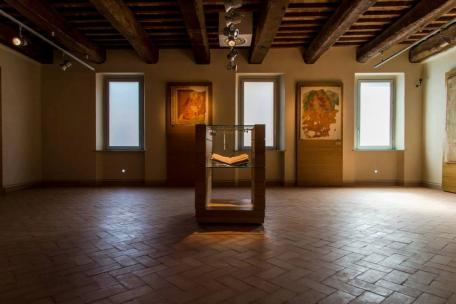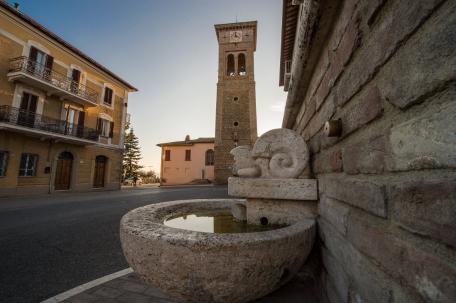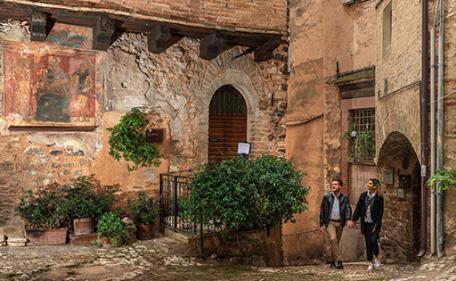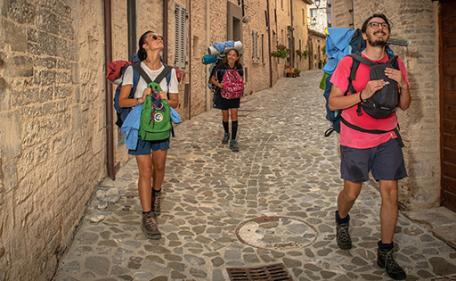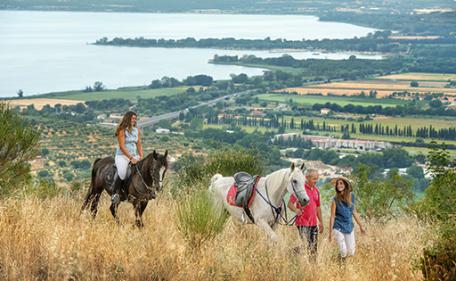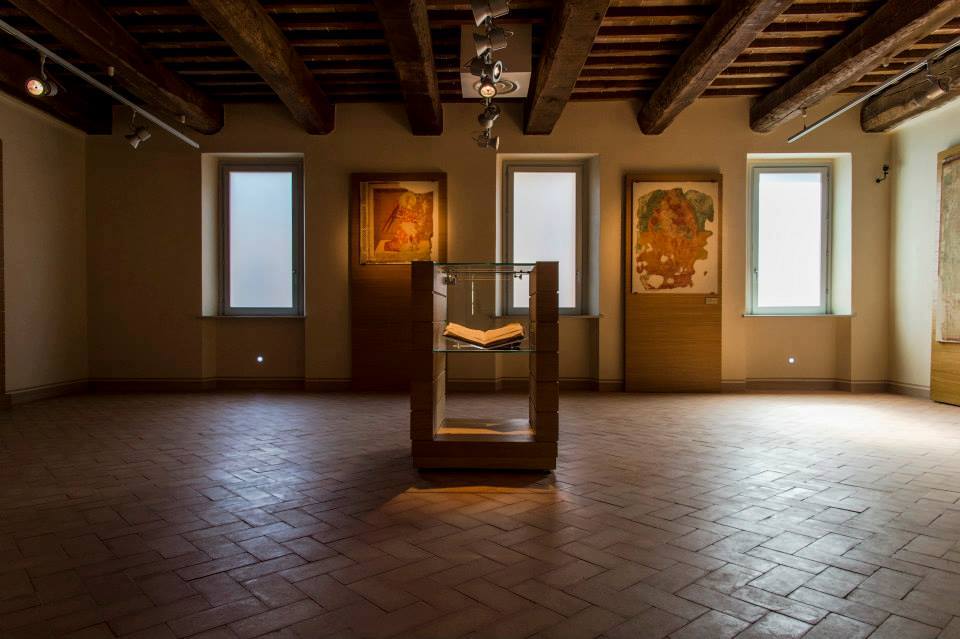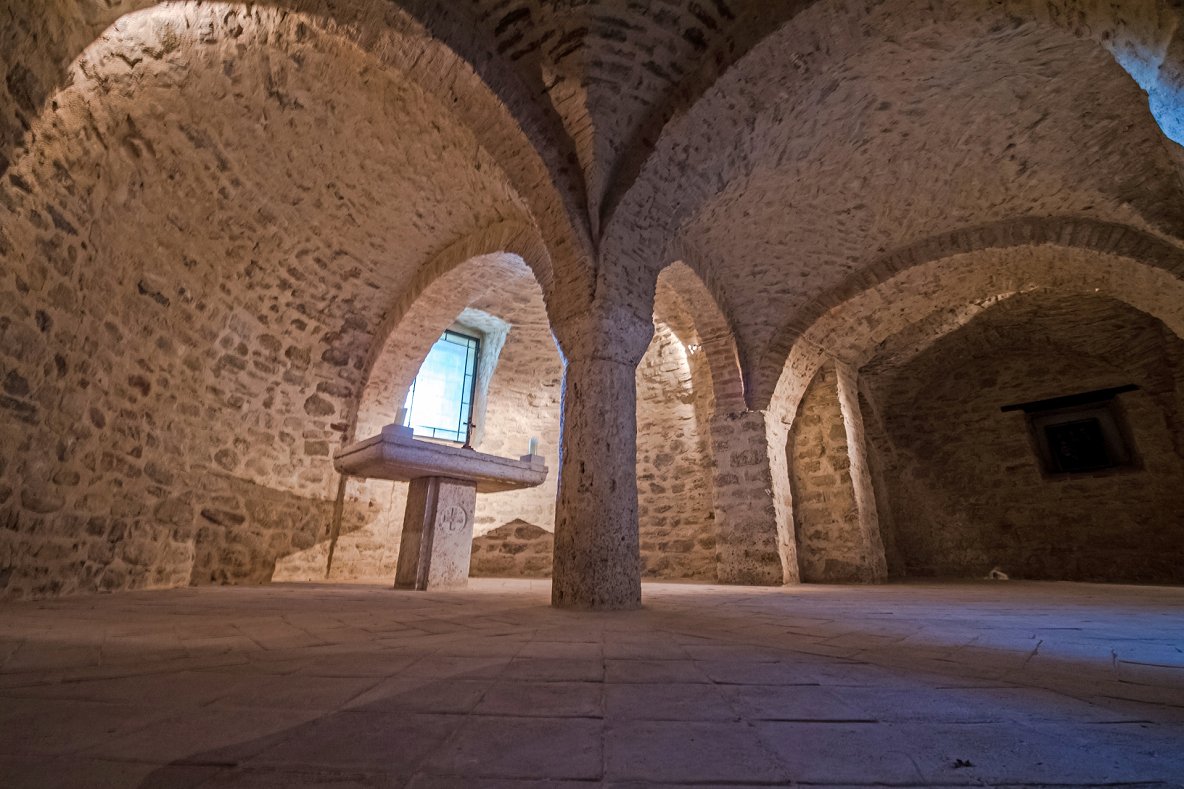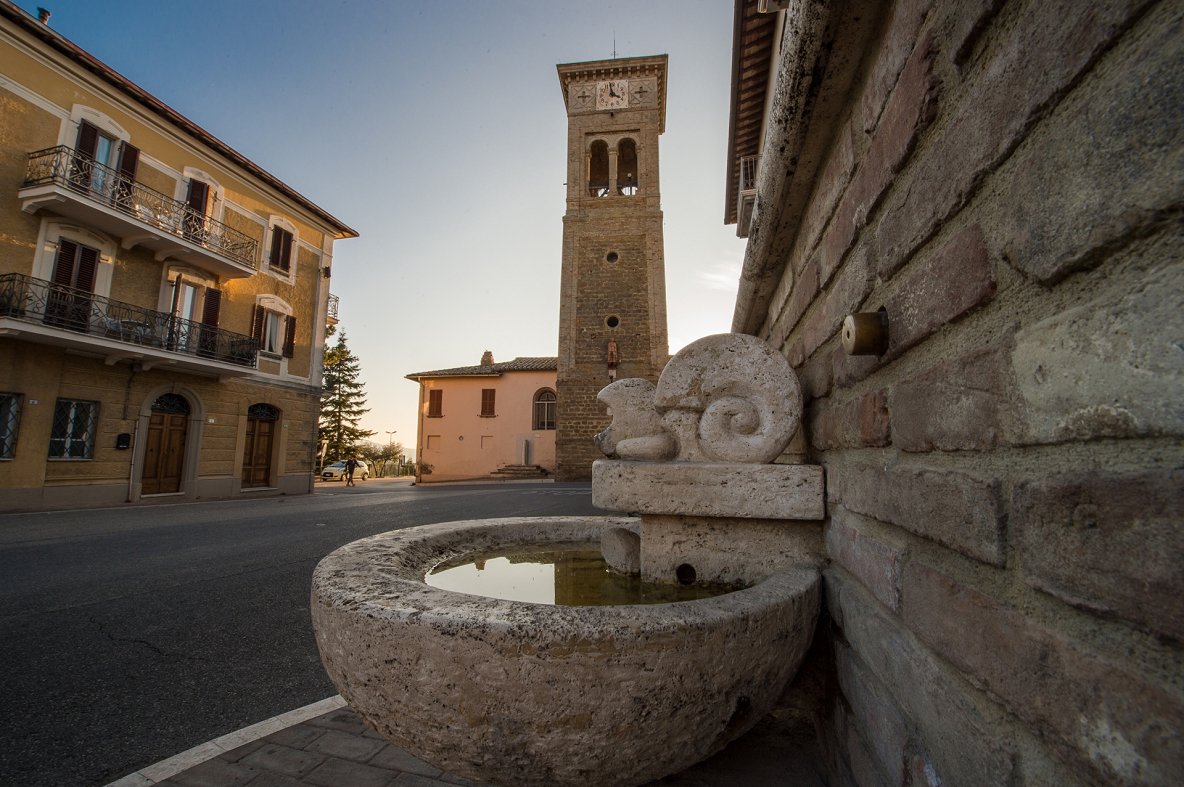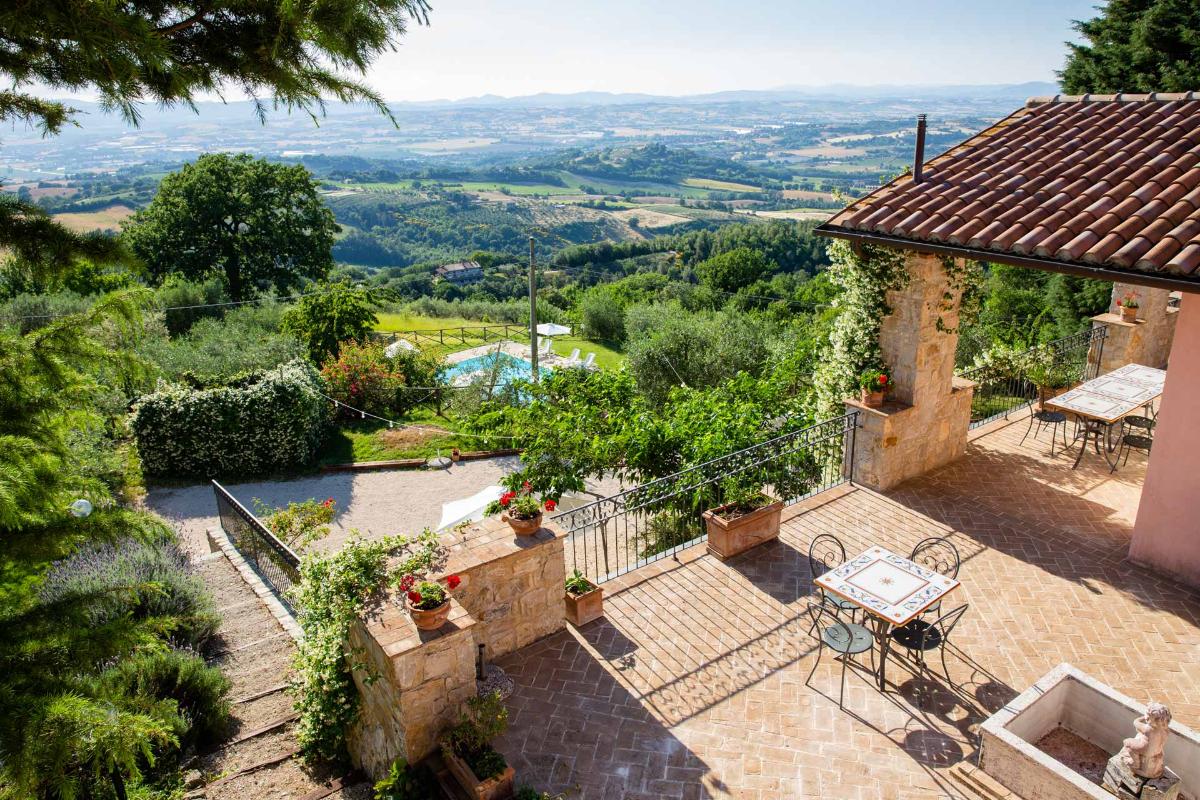| Start | Cannara |
| Arrive | Cannara |
| Distance | 8 km |
| Vertical Drop: | 10 mt |
| Difficulty | easy, flat path |
| Travel time | 2,5 hours (hiking) – 50 minutes (Bike) |
| Suitable for | everyone, even families with children |
| Bike type | city-bike, MTB, gravel |
| Duration | 22:32 hours (trekking) - 6:48 hours (bike) |
A ring trail on a completely flat route, starting from the central Piazza San Matteo in Cannara (Pg). From the main square of San Matteo, where you can visit the homonymous Church of San Matteo, head in the direction of the Assisi-Spoleto cycling path using the asphalted track that runs alongside the bed of the Chiascio river. Continue on the pedestrian/cycle path along the confluence point of Topino river with Chiascio river, up to the waterfalls of the same Chiascio,then continue on a dirt road, in the middle of the cultivated plain, from which you can discover wide views of Mount Subasio and Assisi on one side, and, of the Umbrian Valley and Martani Mountains on the other.
After a sharp turn on the left of the gravel path, continue on the route in a flat segment between Cannara and Bevagna, north east from Mount Subasio and south-west from the of Montefalco hills, up to the place of San Francesco’s sermon to the birds in Piandarca.
Here, according to Franciscan scholars, the poor man from Assisi noticed the presence of a multitude of birds to which he addressed his sermon. Halfway through, on the left bank of the Formella torrent, there is a stone, which various early 20th century-documents identify with the one on which the Saint would have preached to the birds between 1212 and 1213. Going to the right, after a few meters, it is possible to admire the large TAU of Piandarca, facing
Assisi, realized with a different cut of the vegetation that makes it visible through a different chromatic effect. Leaving the TAU behind, it is possible to take a little detour to the left to reach the ancient road that connects Cannara and Bevagna, where you can visit the Piandarca Shrine, a small shrine built near a stream in 1926, on the occasion of the seventh centenary of San Francesco’s death and in memory of his sermon to the birds that took place in this territory.
Going backwards on the cycling path detour, you reach Vocabolo Fonte, continue leaving the dirt road towards Cannara where, after passing the highway intersection, cross the historic center and head to the end point in Piazza San Matteo.
In the historic center of Cannara, near the route, it is possible to visit:
● The Church of San Matteo
The fourteenth century church was converted into its present form in the years 1788 – 1793, according to the project of an architect Giuseppe Brizi. The spired bell tower partially collapsed after the earthquake of 1832, it was rebuilt with the current end cap by the engeneer Domenico Martinangeli in 1860. Inside is exposed an interesting table Nicolò di Liberatore, representing the Madonna Enthroned with Jesus Child between St. Francis of Assisi and St. Matthew the Evangelist.
● Museum of the town of Cannara
Housed inside the former Salesian convent, the Museum of the Town of Cannara is dedicated to the history of Cannara and the surrounding area and offers the opportunity to get to know and understand the history of the area from its origins to the modern day. The rooms hold a conspicuous collection of archeological material from the excavation of Urvinum Hortense, in Collemancio, evidence the site was occupied from pre-Roman times to the late Middle Ages. The Museum also houses a collection of medieval and modern paintings and sculptures from the main churches in the town and from some of the noble palaces. The tour begins on the ground floor: the first room displays a collection not only of wind and percussion musical instruments from the early 20th century, but also scores and photographs of the period, which bear witness to the solid musical tradition of the town of Cannara. The archeological tour begins on the same floor and the pride and joy of the collection is the polychrome mosaic from the thermal baths of Urvinum Hortense, which can be viewed from above. It’s the biggest find discovered in the ancient Roman municipium and it dates back to the 1st and the 2nd century AD. It decorated the floor of one of the rooms in the public thermal baths, specifically the bath of the frigidarium. The background is in white tiles, with a frame of red and black tiles. Along the four sides, surrounded by luxuriant vegetation, six caricatured pygmies are represented, victims of exotic animals: hippos, crocodiles, ibises and snakes. The central painting, on the other hand, represents a funny scene of four pygmies intent on fishing on tiny boats.Some display cases contain the materials found in the excavations. Next to the archeological section, there is room for the art collections of the Civic Art Gallery. The frescoes torn down in 1907 from the Church of the Madonna del Latte, also known as Santa Maria delle Fontanelle, near Collemancio, occupy a whole room of the Picture Gallery. The entire decoration was removed, as the church building was gradually deteriorating. It was painted by artists from Perugia, from Umbria and from the circle of Tiberius of Assisi. Of particular importance is the fourteenth century Madonna del Latte. The Picture Gallery also houses works by Marcantonio Grecchi, whose painting was austere and rigorous, by Dono Doni of Assisi, with an eclectic but effective style in his real life portraits, and by Francesco Longhi.
● The Church of San Biagio
Example of the late Umbrian Romanesque style, the Church of San Biagio presents its old 13th-century façade, built in red and white stones from Assisi. The interior consists of a single room with the vault divided into four sails. The late sixteenth century canvas overlooking the main altar represents the Trinity with, at the bottom, the
Saints Lorenzo and Benedetto (on the right), Biagio and Blessed Lorenzo Giustiniani ( on the left). In front of the entrance there is a Baroque altar; on the walls there are fragments of fourteenth century frescoes. Of high interest, also for the purposes of local religious traditions, are two statues preserved here: the one of S. Biagio (3 February), made in modern times, to which is linked an ancient popular festival, the other is a statue of the Immaculate Virgin, attributed to Nero Alberti (1502-1568), counted among the "Madonnas with hold-up stockings". She is carried in a religious procession on the afternoon of Easter day and brought to meet the statue of the Risen Christ, giving life to the Rinchinata.
● The Church of Buona Morte
The Church of Buona Morte stands in front of the "Tugurio" (hovel) where, according to the tradition, S. Francesco retired to rest and pray when he passed through the land of Cannara.
At that time it was only a small oratory and according to the tradition, the Saint of Assisi dressed the first member of the “Third Order”: the Blessed Lucio Modestini of Cannara. Later on it would become the meeting place of St. Francis’ Company, later known as "Della Morte e Orazione", dedicated above all to works of piety, such as the burial of the dead.
It is a church with a single nave, with five altars, enriched by valuable works of art and tombstones that recall the conception of S. Francesco's Third Order in this sacred building and the high civil or religious role carried out by some Cannaresi in the past.
The valuable "Crucifix" with articulated arms characterized by solid wood joints, is exhibited in the niche above the presbytery and composed of five layers of overlapping linen cloth. It is a rarity in Umbria and dates back to the second half of the fifteenth century. It was purchased by the “Compagnia della Morte” in 1545, as an object of devotion and carried in the religious procession on the evening of Good Friday.
● Majolica - Landrini Palace - The sacred hovel of San Francesco
According to the “Fioretti” and the “Cantico di frate sole”, the Saint used to go between “Cannajo e Bevagno" and in these places numerous testimonies of his passage are preserved, one of these is inside Majolica - Landrini Palace, in Piazza IV Novembre, where the hovel, in which St. Francesco lived during his visits to Cannara, can be admired. Apparently here was born The first Fraternity of the Secular Franciscan Order (O.F.S.) founded by St. Francesco for all those men and women, married or unmarried, who lived outside the convents or monasteries, but still wanted to live their own Christian life following the example of St. Francesco; for them, then, the Saint of Assisi wrote a rule of life known as the "Third Order", approved afterwards by the Pope.
1226 – 1926 “La favilla accesa a Cannara dal verbo di S. Francesco d’Assisi non mai sopita nei secoli divampò in gran fiamma nel settimo centenario del poverello quando in questa casa fu ricostrutto il tugurio in cui la tradizione addita il primo germe del terz’ordine e fu murata un’edicola in Pian d’Arca dove parlando e benedicendo alle sirocchie uccelli il santo poeta preludiò al sublime Cantico delle Creature“.
(1226 - 1926 “The spark lit in Cannara by the word of St. Francis of Assisi, never dormant over the centuries, flared up in great flame in the seventh centenary of the poor man when in this house the hovel was rebuilt, in which, tradition points the first germ of the third order and a shrine was walled up in Pian d'Arca where, speaking and blessing the sirocchie birds, the holy poet prelude to the sublime Canticle of the Creatures “)
